Paddy field


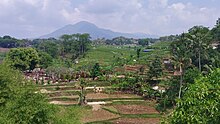

Apaddy fieldis a floodedfieldofarable landused for growingsemiaquaticcrops, most notablyriceandtaro.It originates from theNeolithicrice-farming cultures of theYangtze Riverbasin in southern China, associated withpre-AustronesianandHmong-Miencultures. It was spread in prehistoric times by theexpansionofAustronesian peoplestoIsland Southeast Asia,Madagascar,Melanesia,Micronesia,andPolynesia.The technology was also acquired by other cultures in mainland Asia for rice farming, spreading toEast Asia,Mainland Southeast Asia,andSouth Asia.
Fields can be built into steep hillsides asterracesor adjacent to depressed or steeply sloped features such as rivers ormarshes.They require a great deal of labor and materials to create and need large quantities of water for irrigation.Oxenandwater buffalo,adapted for life inwetlands,are important working animals used extensively in paddy field farming.
Paddy field farming remains the dominant form of growing rice in modern times. It is practiced extensively inBangladesh,Cambodia,China,India,Indonesia,Northern Iran,Japan,Laos,Malaysia,Mongolia,Myanmar,Nepal,North Korea,Pakistan,thePhilippines,South Korea,Sri Lanka,Thailand,Taiwan,andVietnam.[1]It has also been introduced elsewhere since the colonial era, notably inNorthern Italy,theCamargueinFrance,[2]and inSpain,particularly in theAlbufera de Valènciawetlands in theValencian Community,theEbro DeltainCataloniaand theGuadalquivirwetlands inAndalusia,as well as along the eastern coast ofBrazil,theArtibonite ValleyinHaiti,Sacramento ValleyinCalifornia,andWest LothianinScotlandamong other places.
Paddy cultivation should not be confused with cultivation ofdeepwater rice,which is grown in flooded conditions with water more than 50 cm (20 in) deep for at least a month. Global paddies' emissions account for at least 10% of globalmethane emissions.Drip irrigationsystems have been proposed as a possible environmental and commercial solution.
Etymology
[edit]The word "paddy" is derived from theMalay/Indonesianwordpadi,meaning "rice plant",[3]which is itself derived fromProto-Austronesian*pajay ( "rice in the field", "rice plant" ).CognatesincludeAmispanay;Tagalogpálay;Kadazan Dusunpaai;Javanesepari;andChamorrofaʻi,among others.[4]
History
[edit]Neolithic southern China
[edit]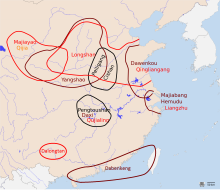
(8500 to 1500 BC)
Genetic evidence shows that all forms of paddy rice, including bothindicaandjaponica,spring from a domestication of the wild riceOryza rufipogonby cultures associated with pre-Austronesian and Hmong-Mien-speakers. This occurred 13,500 to 8,200 years ago south of the Yangtze River in present-day China.[5][6]

There are two likely centers of domestication for rice as well as the development of the wet-field technology. The first is in the lowerYangtze River,believed to be the homelands of the pre-Austronesians and possibly also theKra-Dai,and associated with theKuahuqiao,Hemudu,Majiabang,Songze,Liangzhu,andMaquiaocultures.[7][8][9][10][11]The second is in the middle Yangtze River, believed to be the homelands of the early Hmong-Mien speakers and associated with thePengtoushan,Nanmuyuan,Liulinxi,Daxi,Qujialing,andShijiahecultures.Both of these regions were heavily populated and had regular trade contacts with each other, as well as with earlyAustroasiaticspeakers to the west, and early Kra-Dai speakers to the south, facilitating the spread of rice cultivation throughout southern China.[8][9][11]

The earliest paddy field found dates to 4330 BC, based on carbon dating of grains of rice andsoil organic matterfound at the Chaodun site inKunshan.[12][13]At Caoxieshan, a site of the NeolithicMajiabang culture,archaeologists excavated paddy fields.[14]Some archaeologists claim that Caoxieshan may date to 4000–3000 BC.[15][16]There is archaeological evidence that unhusked rice was stored for the military and for burial with the deceased from theNeolithicperiod to theHan dynastyin China.[17]
By the late Neolithic (3500 to 2500 BC), population in the rice cultivating centers had increased rapidly, centered around theQujialing-ShijiaheandLiangzhucultures. There was also evidence of intensive rice cultivation in paddy fields as well as increasingly sophisticatedmaterial culturesin these two regions. The number of settlements among the Yangtze cultures and their sizes increased, leading some archeologists to characterize them astrue states,with clearly advanced socio-political structures. However, it is unknown if they had centralized control.[18][19]
In the terminal Neolithic (2500 to 2000 BC), Shijiahe shrank in size, and Liangzhu disappeared altogether. This is largely believed to be the result of the southward expansion of the early Sino-TibetanLongshan culture.Fortifications like walls (as well as extensive moats in Liangzhu cities) are common features in settlements during this period, indicating widespread conflict. This period also coincides with the southward movement of rice-farming cultures to theLingnanandFujianregions, as well as the southward migrations of the Austronesian, Kra-Dai, andAustroasiatic-speaking peoples toMainland Southeast AsiaandIsland Southeast Asia.[18][20][21]
Austronesian expansion
[edit]
(3500 BC to AD 1200)

The spread ofjaponicarice cultivation and paddy field agriculture to Southeast Asia started with the migrations of the AustronesianDapenkeng cultureintoTaiwanbetween 3500 and 2000 BC. The Nanguanli site in Taiwan, dated to ca. 2800 BC, has yielded numerous carbonized remains of both rice and millet in waterlogged conditions, indicating intensive wetland rice cultivation and dryland millet cultivation.[9]

From about 2000 to 1500 BC, the Austronesian expansion began, with settlers from Taiwan moving south to migrate toLuzonin thePhilippines,bringing rice cultivation technologies with them. From Luzon, Austronesians rapidly colonized the rest ofMaritime Southeast Asia,moving westwards toBorneo,theMalay PeninsulaandSumatra;and southwards toSulawesiandJava.By 500 BC, there is evidence of intensive wetland rice agriculture already established in Java andBali,especially near very fertile volcanic islands.[9]
Rice did not survive the Austronesian voyages intoMicronesiaandPolynesia;however, wet-field agriculture was transferred to the cultivation of other crops, most notably fortarocultivation. The AustronesianLapita culturealso came into contact with the non-Austronesian (Papuan) early agriculturists ofNew Guineaand introduced wetland farming techniques to them. In turn, they assimilated their range of indigenous cultivated fruits and tubers before spreading further eastward toIsland MelanesiaandPolynesia.[9]
Rice and wet-field agriculture were also introduced toMadagascar,theComoros,and the coast ofEast Africaaround the 1st millennium AD by Austronesian settlers from theGreater Sunda Islands.[22]
Korea
[edit]There are ten archaeologically excavated rice paddy fields in Korea. The two oldest are the Okhyun and Yaumdong sites, found inUlsan,dating to the earlyMumun pottery period.[23]
Paddy field farming goes back thousands of years in Korea. Apit-houseat the Daecheon-ni site yielded carbonized rice grains and radiocarbon dates, indicating that rice cultivation in dry-fields may have begun as early as the MiddleJeulmun pottery period(c. 3500–2000 BC) in theKorean Peninsula.[24]Ancient paddy fields have been carefully unearthed in Korea by institutes such asKyungnam UniversityMuseum (KUM) ofMasan.They excavated paddy field features at the Geumcheon-ni Site nearMiryang,South Gyeongsang Province.The paddy field feature was found next to a pit-house that is dated to the latter part of the Early Mumun pottery period (c. 1100–850 BC). KUM has conducted excavations, that have revealed similarly dated paddy field features, at Yaeum-dong and Okhyeon, in modern-dayUlsan.[25]
The earliest Mumun features were usually located in low-lying narrow gullies, that were naturally swampy and fed by the local stream system. Some Mumun paddy fields in flat areas were made of a series of squares and rectangles, separated by bunds approximately 10 cm in height, while terraced paddy fields consisted of long irregular shapes that followed natural contours of the land at various levels.[26][27]
Mumun Period rice farmers used all of the elements that are present in today's paddy fields, such as terracing, bunds, canals, and small reservoirs. We can grasp some paddy-field farming techniques of the Middle Mumun (c. 850–550 BC), from the well-preserved wooden tools excavated from archaeological rice fields at the Majeon-ni Site. However, iron tools for paddy-field farming were not introduced until sometime after 200 BC. The spatial scale of paddy-fields increased, with the regular use of iron tools, in theThree Kingdoms of KoreaPeriod (c. AD 300/400-668).[citation needed]
Japan
[edit]The first paddy fields in Japan date to the EarlyYayoi period(300 BC – 250 AD).[28]The Early Yayoi has been re-dated,[29]and based on studies of early Japanese paddy formations in Kyushu it appears that wet-field rice agriculture in Japan was directly adopted from the Lower Yangtze river basin in Eastern China.[citation needed]
Culture
[edit]| China | 204.3 |
| India | 152.6 |
| Indonesia | 69.0 |
| Vietnam | 43.7 |
| Thailand | 37.8 |
| Bangladesh | 33.9 |
| Myanmar | 33.0 |
| Philippines | 18.0 |
| Brazil | 11.5 |
| Japan | 10.7 |
| Pakistan | 9.4 |
| Cambodia | 9.3 |
| United States | 9.0 |
| Korea | 6.4 |
| Egypt | 5.9 |
| Nepal | 5.1 |
| Nigeria | 4.8 |
| Madagascar | 4.0 |
| Sri Lanka | 3.8 |
| Laos | 3.5 |
| Source: Food and Agriculture Organization | |
China
[edit]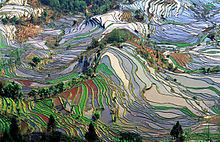
Although China's agricultural output is the largest in the world, only about 15% of its total land area can be cultivated. About 75% of the cultivated area is used for food crops. Rice is China's most important crop, raised on about 25% of the cultivated area. Most rice is grown south of theHuai River,in the Yangtze valley, theZhu Jiangdelta, and inYunnan,Guizhou,andSichuanprovinces.[citation needed]
Rice appears to have been used by the EarlyNeolithicpopulations of Lijiacun and Yunchanyan in China.[31]Evidence of possible rice cultivation from ca. 11,500 BP has been found, however it is still questioned whether the rice was indeed being cultivated, or instead beinggatheredas wild rice.[32]Bruce Smith, an archaeologist at theSmithsonian Institutionin Washington, D.C., who has written on the origins of agriculture, says that evidence has been mounting that the Yangtze was probably the site of the earliest rice cultivation.[33]In 1998, Crawford & Shen reported that the earliest of 14 AMS or radiocarbon dates on rice from at least nine Early to Middle Neolithic sites is no older than 7000 BC, that rice from theHemuduand Luojiajiao sites indicates that rice domestication likely began before 5000 BC, but that most sites in China from which rice remains have been recovered are younger than 5000 BC.[31]

During theSpring and Autumn period(722–481 BC), two revolutionary improvements infarming technologytook place. One was the use ofcast iron toolsandbeasts of burdento pull plows, and the other was the large-scale harnessing of rivers and development ofwater conservationprojects.Sunshu Aoof the 6th century BC andXimen Baoof the 5th century BC are two of the earliest hydraulic engineers from China, and their works were focused upon improvingirrigationsystems.[34]These developments were widely spread during the ensuingWarring States period(403–221 BC), culminating in the enormousDu Jiang Yan Irrigation Systemengineered byLi Bingby 256 BC for theState of Qinin ancientSichuan.During theEastern Jin(317–420) and theNorthern and Southern Dynasties(420–589), land-use became more intensive and efficient, rice was grown twice a year and cattle began to be used forplowingandfertilization.
By about 750, 75% of China's population lived north of the Yangtze, but by 1250, 75% of China's population lived south of it. Such large-scale internal migration was possible due to introduction of quick-ripening strains of rice from Vietnam suitable for multi-cropping.[35]
Famous rice paddies in China include theLongsheng Rice Terracesand the fields ofYuanyang County, Yunnan.[citation needed]
India
[edit]
India has the largest paddy output in the world and is also the largest exporter of rice in the world as of 2020. In India,West Bengalis the largest rice producing state.[36]Paddy fields are a common sight throughout India, both in the northernGangetic Plainsand the southern peninsular plateaus. Paddy is cultivated at least twice a year in most parts of India, the two seasons being known asRabiandKharifrespectively. The former cultivation is dependent on irrigation, while the latter depends onthe Monsoon.The paddy cultivation plays a major role in socio-cultural life of rural India. Many regional festivals celebrate the harvest, such asOnam,Bihu,Thai Pongal,Makar Sankranti,andNabanna.TheKaveridelta region ofThanjavuris historically known as the rice bowl ofTamil Nadu,andKuttanaduis called the rice bowl ofKerala.Gangavathiis known as the rice bowl ofKarnataka.[citation needed]
Indonesia
[edit]
Prime Javanese paddies yield roughly 6 metric tons of unmilled rice (2.5 metric tons of milled rice) perhectare.When irrigation is available, rice farmers typically plantGreen Revolutionrice varieties allowing three growing seasons per year. Since fertilizer and pesticide are relatively expensive inputs, farmers typically plant seeds in a very small plot. Three weeks following germination, the 15-20 centimetre (6–8 in) stalks are picked and replanted at greater separation, in a backbreaking manual procedure.
Rice harvesting inCentral Javais often performed not by owners orsharecroppersof paddies, but rather by itinerant middlemen, whose small firms specialize in the harvest, transport, milling, and distribution of rice.
The fertile volcanic soil of much of the Indonesian archipelago—particularly the islands of Java and Bali—has made rice a central dietary staple. Steep terrain on Bali resulted in complex irrigation systems, locally calledsubak,to manage water storage and drainage for rice terraces.[37]
Italy
[edit]
Rice is grown in Northern Italy, especially in the valley of thePo River.[38]The paddy fields are irrigated by fast-flowing streams descending from theAlps.In the 19th century and much of the 20th century, the paddy fields were farmed by themondine,a subculture of seasonal rice paddy workers composed mostly of poor women.[citation needed]
Japan
[edit]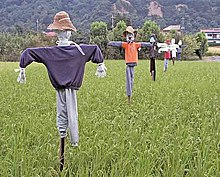
The acidic soil conditions common in Japan due to volcanic eruptions have made the paddy field the most productive farming method. Paddy fields are represented by thekanjiĐiền(commonly read astaor asden) that has had a strong influence on Japanese culture. In fact, the characterĐiền,which originally meant 'field' in general, is used in Japan exclusively to refer to paddy fields. One of the oldest samples of writing in Japan is widely credited to the kanjiĐiềnfound on pottery at the archaeological site ofMatsutakainMie Prefecturethat dates to the late 2nd century.
Ta(Điền) is used as a part of manyplace namesas well as in many family names. Most of these places are somehow related to the paddy field and, in many cases, are based on the history of a particular location. For example, where a river runs through a village, the place east of the river may be calledHigashida(Đông điền), literally "east paddy field." A place with a newly irrigated paddy field, especially those made during or after theEdo period,may be calledNittaorShinden(bothTân điền), "new paddy field." In some places, lakes and marshes were likened to a paddy field and were named withta,likeHakkōda(Bát giáp điền).
Today, many family names havetaas a component, a practice which can be largely attributed to a government edict in the earlyMeiji Periodwhich required all citizens to have a family name. Many chose a name based on some geographical feature associated with their residence or occupation, and as nearly three-fourths of the population were farmers, many made family names usingta.Some common examples areTanaka(Điền trung), literally meaning "in the paddy field;"Nakata(Trung điền), "middle paddy field;"Kawada( xuyên điền ), "river paddy field;" andFuruta(Cổ điền), "old paddy field."[citation needed]
In recent years, rice consumption in Japan has fallen and many rice farmers are increasingly elderly. The government has subsidized rice production since the 1970s, and favorsprotectionistpolicies regarding cheaper imported rice.[39]
Korea
[edit]
Arable land in small alluvial flats of most rural river valleys in South Korea are dedicated to paddy-field farming. Farmers assess paddy fields for any necessary repairs in February. Fields may be rebuilt, andbundbreaches are repaired. This work is carried out until mid-March, when warmer spring weather allows the farmer to buy or grow rice seedlings. They are transplanted (usually byrice transplanter) from the indoors into freshly flooded paddy fields in May. Farmers tend and weed their paddy fields through the summer until around the time ofChuseok,a traditional holiday held on 15 August of theLunar Calendar(circa mid-September on the Solar Calendar). The harvest begins in October. Coordinating the harvest can be challenging because many Korean farmers have small paddy fields in a number of locations around their villages, and modern harvesting machines are sometimes shared between extended family members. Farmers usually dry the harvested grains in the sun before bringing them to market.[citation needed]
TheHanjacharacter for 'field',jeon(Korean:전;Hanja:Điền), is found in some place names, especially small farming townships and villages. However, the specific Korean term for 'paddy' is a purely Korean word, "non" (Korean:논).[citation needed]
Madagascar
[edit]
InMadagascar,the average annual consumption of rice is 130 kg per person, one of the largest in the world.
According to a 1999 study of UPDRS / FAO:
The majority of rice is related to irrigation (1,054,381 ha). The choice of methods conditioning performance is determined by the variety and quality control of water.
Thetavyis traditionally the culture of floodedupland riceon burning of cleared natural rain forest (135,966 ha). Criticized as being the cause of deforestation,tavyis still widely practiced by farmers in Madagascar, who find a good compromise between climate risks, availability of labour and food security.
By extension, thetanety,which literally means "hill," is also growing upland rice, carried out on the grassy slopes that have been deforested for the production of charcoal (139,337 ha).
Among the many varieties, rice of Madagascar includes:Vary lava- a translucent long and large grain rice, considered a luxury rice;Vary Makalioka- a translucent long and thin grain rice;Vary Rojofotsy- a half-long grain rice; andVary mena,or red rice, exclusive to Madagascar.[citation needed]
Malaysia
[edit]
Paddy fields can be found in most states on theMalaysian Peninsula,with most of the fields being located in the northern states such asKedah,Perlis,Perak,andPenang.Paddy fields can also be found on Malaysia's east coast region, inKelantanandTerengganu.The central state ofSelangoralso has its fair share of paddy fields, especially in the districts ofKuala SelangorandSabak Bernam.[citation needed]
Before Malaysia became heavily reliant on its industrial output, people were mainly involved in agriculture, especially in the production of rice. It was for that reason, that people usually built their houses next to paddy fields. The very spicychili pepperthat is often eaten in Malaysia, thebird's eye chili,is locally calledcili padi,literally "paddy chili". Some research pertaining to Rainfed lowland rice inSarawakhas been reported.[1]
Myanmar
[edit]
Rice is grown in Myanmarprimarily in three areas – theIrrawaddy Delta,the area along and the delta of theKaladan River,and the Central plains aroundMandalay,though there has been an increase in rice farming inShan StateandKachin Statein recent years.[40]Up until the later 1960s, Myanmar was the main exporter of rice. Termed the rice basket of Southeast Asia, much of the rice grown in Myanmar does not rely on fertilizers and pesticides, thus, although "organic" in a sense, it has been unable to cope with population growth and other rice economies which utilized fertilizers.
Rice is now grown in all the three seasons of Myanmar, though primarily in theMonsoonseason – from June to October. Rice grown in the delta areas relies heavily on the river water and sedimented minerals from the northern mountains, whilst the rice grown in the central regions require irrigation from theIrrawaddy River.
The fields are tilled when the first rains arrive – traditionally measured at 40 days afterThingyan,theBurmese New Year– around the beginning of June. In modern times, tractors are used, but traditionally, buffalos were employed. The rice plants are planted in nurseries and then transplanted by hand into the prepared fields. The rice is then harvested in late November – "when the rice bends with age". Most of the rice planting and harvesting is done by hand. The rice is then threshed and stored, ready for the mills.[citation needed]
Nepal
[edit]
In Nepal, rice (Nepali: धान, Dhaan) is grown in theTeraiand hilly regions. It is mainly grown during thesummer monsoon in Nepal.[41]
Philippines
[edit]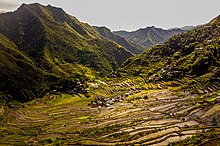
Paddy fields are a common sight in the Philippines. Several vast paddy fields exist in theprovincesofIfugao,Nueva Ecija,Isabela,Cagayan,Bulacan,Quezon,and other provinces.Nueva Ecijais considered the main rice growing province of thePhilippines.[citation needed]
TheBanaue Rice Terracesare an example of paddy fields in the country. They are located inBanauein NorthernLuzon,Philippines and were built by theIfugaos2,000 years ago.[42]Streams and springs found in the mountains were tapped and channeled into irrigation canals that run downhill through the rice terraces. Other notablePhilippinepaddy fields are the Batad Rice Terraces, the Bangaan Rice Terraces, the Mayoyao Rice Terraces and the Hapao Rice Terraces.[43]
Located at Barangay Batad in Banaue, the Batad Rice Terraces are shaped like anamphitheatre,and can be reached by a 12-kilometer ride from Banaue Hotel and a 2-hour hike uphill through mountain trails. The Bangaan Rice Terraces portray the typical Ifugao community, where the livelihood activities are within the village and its surroundings. The Bangaan Rice Terraces are accessible by a one-hour ride from Poblacion, Banaue, then a 20-minute trek down to the village. It can be viewed best from the road toMayoyao.The Mayoyao Rice Terraces are located at Mayoyao, 44 kilometers away from Poblacion, Banaue. The town ofMayoyaolies in the midst of these rice terraces. All dikes are tiered with flat stones. The Hapao Rice Terraces are within 55 kilometers from the capital town ofLagawe.OtherIfugaostone-walled rice terraces are located in the municipality ofHungduan.[43]
Sri Lanka
[edit]
Sri Lankan paddy cultivationhistory dates back to more than 2000 years ago. The historical reports say that Sri Lanka is regarded as the "paddy store of the east" because it produced an excessive quantity of rice. Paddy cultivation can be found all over the island and a considerable amount of land is allocated for it. Both upcountry and low country wetlands use paddy cultivation. The majority of paddy land is in the dry zone, and it uses special irrigation systems for cultivation. The water storing tank called "Wewa" facilitates a supply of water to paddy lands in the cultivation period.Agriculture in Sri Lankamainly depends on rice production.[44]Sri Lanka sometimes exports rice to its neighboring countries. Around 1.5 million hectares of land are cultivated in Sri Lanka for paddy in 2008/2009 maha: 64% of which is cultivated during the dry season and 35% cultivated during the wet season. Around 879,000 farmer families are engaged in paddy cultivation in Sri Lanka. They make up 20% of the country's population and 32% of the employment.[citation needed]
Thailand
[edit]
Rice production in Thailandrepresents a significant portion of theThai economy.It uses over half of the farmable land area and labor force in Thailand.[45]
Thailand has a strong tradition of rice production. It has the fifth-largest amount of land used for ricecultivationin the world and is the world's largest exporter of rice.[46]Thailand has plans to further increase its land available for rice production, with a goal of adding 500,000hectaresto the 9.2 million hectares of rice-growing areas already cultivated.[47]TheThai Ministry of Agricultureexpected rice production to yield around 30 million tons of rice for 2008.[48]The most produced strain of rice in Thailand isjasmine rice,which has a significantly loweryield ratethan other types of rice, but also normally fetches more than double the price of otherstrainsin a global market.[47]
Vietnam
[edit]
Rice fields in Vietnam (ruộngorcánh đồngin Vietnamese) are the predominant land use in the valley of theRed Riverand theMekong Delta.In theRed River Deltaof northern Vietnam, control of seasonal river flooding is achieved by an extensive network ofdykeswhich over the centuries total some 3000 km. In theMekong Deltaof southern Vietnam, there is an interlacing drainage and irrigation canal system that has become the symbol of this area. The canals additionally serve as transportation routes, allowing farmers to bring their produce to market. In Northwestern Vietnam,Thai peoplebuilt their"valley culture"based on the cultivation ofglutinous riceplanted in upland fields, requiring terracing of the slopes.
The primary festival related to the agrarian cycle is"lễ hạ điền"(literally "descent into the fields" ) held as the start of the planting season in hope of a bountiful harvest. Traditionally, the event was officiated with much pomp. The monarch carried out the ritual plowing of the first furrow while local dignitaries and farmers followed suit.Thổ địa(deities of the earth),thành hoàng làng(the village patron spirit),Thần Nông(god of agriculture), andthần lúa(god of rice plants) were all venerated with prayers and offerings.
In colloquialVietnamese,wealth is frequently associated with the vastness of the individual's land holdings. Paddy fields so large as for "storks to fly with their wings out-stretched" ( "đồng lúa thẳng cánh cò bay") can be heard as a common metaphor. Wind-blown undulating rice plants across a paddy field in literary Vietnamese is termed figuratively" waves of rice plants "("sóng lúa").[citation needed]
Ecology
[edit]Paddy fields are a major source ofatmospheric methanewhich contributes toglobal warming,having been estimated to contribute in the range of 50 to 100 million tonnes of the gas per annum.[49][50]Studies have shown that this can be significantly reduced while also boostingcrop yieldby draining the paddies to allow the soil to aerate to interrupt methane production.[51]Studies have also shown the variability in assessment of methane emission using local, regional and global factors and calling for better inventorization based on micro level data.[52]
Rice paddies are responsible for 10% of global methane emissions, roughly equal to the emissions of the aviation industry.[53]Drip irrigation systems developed byNetafimand N-Drip were introduced in several countries and according to the Times of Israel can reduce up to 85% of emissions.[54]
Gallery
[edit]See also
[edit]- Kuk Swamp
- Rice-fish system
- Upland rice– Rice grown in dry fields
References
[edit]- ^abSang, Anisia Jati; Tay, Kai Meng; Lim, Chee Peng; Saeid, Nahavandi (2018)."Application of a Genetic-Fuzzy FMEA to Rainfed Lowland Rice Production in Sarawak: Environmental, Health, and Safety Perspectives".IEEE Access.6:74628–74647.Bibcode:2018IEEEA...674628S.doi:10.1109/ACCESS.2018.2883115.hdl:10536/DRO/DU:30118456.
- ^"Riz de Camargue, Silo de Tourtoulen, Riz blanc de Camargue, Riz et céréales de Camargue".Riz-camargue.com.Retrieved25 April2013.
- ^"paddy".Merriam Webster.Retrieved15 July2007.
- ^Blust, Robert; Trussel, Stephen."*pajay— rice in the field; rice plant ".Austronesian Comparative Dictionary.Retrieved29 June2019.
- ^Molina, J.; Sikora, M.; Garud, N.; Flowers, J. M.; Rubinstein, S.; Reynolds, A.; Huang, P.; Jackson, S.; Schaal, B. A.; Bustamante, C. D.; Boyko, A. R.; Purugganan, M. D. (2011)."Molecular evidence for a single evolutionary origin of domesticated rice".Proceedings of the National Academy of Sciences.108(20): 8351–6.Bibcode:2011PNAS..108.8351M.doi:10.1073/pnas.1104686108.PMC3101000.PMID21536870.
- ^Gross, B. L.; Zhao, Z. (2014)."Archaeological and genetic insights into the origins of domesticated rice".Proceedings of the National Academy of Sciences.111(17): 6190–7.Bibcode:2014PNAS..111.6190G.doi:10.1073/pnas.1308942110.PMC4035933.PMID24753573.
- ^Zhang, Jianping; Lu, Houyuan; Gu, Wanfa; Wu, Naiqin; Zhou, Kunshu; Hu, Yayi; Xin, Yingjun; Wang, Can; Kashkush, Khalil (17 December 2012)."Early Mixed Farming of Millet and Rice 7800 Years Ago in the Middle Yellow River Region, China".PLOS ONE.7(12): e52146.Bibcode:2012PLoSO...752146Z.doi:10.1371/journal.pone.0052146.PMC3524165.PMID23284907.
- ^abcHe, Keyang; Lu, Houyuan; Zhang, Jianping; Wang, Can; Huan, Xiujia (7 June 2017)."Prehistoric evolution of the dualistic structure mixed rice and millet farming in China".The Holocene.27(12): 1885–1898.Bibcode:2017Holoc..27.1885H.doi:10.1177/0959683617708455.S2CID133660098.
- ^abcdefBellwood, Peter (9 December 2011)."The Checkered Prehistory of Rice Movement Southwards as a Domesticated Cereal—from the Yangzi to the Equator"(PDF).Rice.4(3–4): 93–103.Bibcode:2011Rice....4...93B.doi:10.1007/s12284-011-9068-9.S2CID44675525.
- ^Hsieh, Jaw-shu; Hsing, Yue-ie Caroline; Hsu, Tze-fu; Li, Paul Jen-kuei; Li, Kuang-ti; Tsang, Cheng-hwa (24 December 2011)."Studies on Ancient Rice—Where Botanists, Agronomists, Archeologists, Linguists, and Ethnologists Meet".Rice.4(3–4): 178–183.Bibcode:2011Rice....4..178H.doi:10.1007/s12284-011-9075-x.
- ^abLi, Hui; Huang, Ying; Mustavich, Laura F.; Zhang, Fan; Tan, Jing-Ze; Wang, ling-E; Qian, Ji; Gao, Meng-He; Jin, Li (2007)."Y chromosomes of prehistoric people along the Yangtze River"(PDF).Human Genetics.122(3–4): 383–388.doi:10.1007/s00439-007-0407-2.PMID17657509.S2CID2533393.Archived fromthe original(PDF)on 14 December 2013.
- ^Cao, Zhihong; Fu, Jianrong; Zou, Ping; Huang, Jing Fa; Lu, Hong; Weng, Jieping; Ding, Jinlong (August 2010)."Origin and chronosequence of paddy soils in China".Proceedings of the 19th World Congress of Soil Science:39–42.Retrieved8 February2013.
- ^Bellwood, Peter (1997). "Prehistory of the Indo-Malaysian Archipelago".Prehistory of the Indo-Malaysian Archipelago: Revised Edition.Honolulu: University of Hawaiʻi Press. pp. 205–211.ISBN0824818830.JSTORj.ctt24hf81.
- ^Fujiwara, H. (ed.).Search for the Origin of Rice Cultivation: The Ancient Rice Cultivation in Paddy Fields at the Cao Xie Shan Site in China.Miyazaki: Society for Scientific Studies on Cultural Property, 1996. (In Japanese and Chinese)
- ^Fujiwara 1996
- ^Tsude, Hiroshi. Yayoi Farmers Reconsidered: New Perspectives on Agricultural Development in East Asia.Bulletin of the Indo-Pacific Prehistory Association21(5):53–59, 2001.
- ^"Expansion of Chinese Paddy Rice to the Yunnan-Guizhou Plateau".Archived fromthe originalon 27 September 2007.Retrieved6 August2007.
- ^abZhang, Chi; Hung, Hsiao-Chun (2008)."The Neolithic of Southern China – Origin, Development, and Dispersal"(PDF).Asian Perspectives.47(2).
- ^Zhang, Chi (2013). "The Qujialing–Shijiahe culture in the middle Yangzi River valley". In Underhill, Anne P. (ed.).A Companion to Chinese Archaeology.John Wiley & Sons. pp. 510–534.ISBN9781118325780.
- ^Liu, Li; Chen, Xingcan (2012).The Archaeology of China: From the Late Paleolithic to the Early Bronze Age.Cambridge University Press.ISBN9780521643108.
- ^Major, John S.; Cook, Constance A. (2016).Ancient China: A History.Taylor & Francis.ISBN9781317503668.
- ^Beaujard, Philippe (August 2011)."The first migrants to Madagascar and their introduction of plants: linguistic and ethnological evidence"(PDF).Azania: Archaeological Research in Africa.46(2): 169–189.doi:10.1080/0067270X.2011.580142.S2CID55763047.
- ^Crawford, Gary W. and Gyoung-Ah Lee. Agricultural Origins in the Korean Peninsula.Antiquity77(295):87–95, 2003.
- ^Crawford and Lee 2003
- ^Bale, Martin T. Archaeology of Early Agriculture in Korea: An Update on Recent Developments.Bulletin of the Indo-Pacific Prehistory Association21(5):77–84, 2001.
- ^Bale 2001
- ^Kwak, Jong-chul. Urinara-eui Seonsa – Godae Non Bat Yugu [Dry- and Wet-field Agricultural Features of the Korean Prehistoric].InHanguk Nonggyeong Munhwa-eui Hyeongseong[The Formation of Agrarian Societies in Korea]: 21–73. Papers of the 25th National Meetings of theKorean Archaeological Society,Busan, 2001
- ^Barnes, Gina L. Paddy Soils Now and Then.World Archaeology22(1):1–17, 1990.
- ^Shōda, Shinya (2007)."A Comment on the Yayoi Period Dating Controversy".Bulletin of the Society for East Asian Archaeology.1.
- ^fao.org (FAOSTAT)."Countries by commodity (Rice, paddy)".Retrieved11 February2014.
- ^abCrawford and Shen 1998
- ^Harrington, Spencer P.M. (11 June 1997)."Earliest Rice".Archaeology.Archaeological Institute of America.
Rice cultivation began in China ca. 11,500 years ago, some 3,500 years earlier than previously believed
- ^Normile, Dennis (1997). "Yangtze seen as earliest rice site".Science.275(5298): 309–310.doi:10.1126/science.275.5298.309.S2CID140691699.
- ^Needham, Joseph(1986).Science and Civilization in China: Volume 4, Physics and Physical Technology, Part 3, Civil Engineering and Nautics.Taipei: Caves Books Ltd. Page 271.
- ^Angus, Maddison (21 September 2006).The World Economy, Angus Maddison, p.20, ISBN 92-64-02261-9.OECD.ISBN9789264022614.Retrieved25 April2013.
- ^"Top 10 Rice Producing States of India, Indian States with Highest Rice Production".Mapsofindia.com. 17 January 2012.Retrieved25 April2013.
- ^"Lansing and Miller"(PDF).Archived fromthe original(PDF)on 27 March 2009.Retrieved25 April2013.
- ^"Channel 4 notes for schools".Channel4.com.Retrieved25 April2013.
- ^"Economist.com".The Economist.17 December 2009.Retrieved25 April2013.
- ^"Increasing rice production in Myanmar".Archived fromthe originalon 25 September 2015.Retrieved4 May2015.
- ^"New Agriculturist: Country profile - Nepal".www.new-ag.info.
- ^UNESCO World Heritage Centre."Rice Terraces of the Philippine Cordilleras – UNESCO World Heritage Centre".Whc.unesco.org.Retrieved5 May2015.
- ^ab"Error".Retrieved1 April2011.
- ^"Rice Knowledge for Sri Lanka - IRRI Rice Knowledge Bank".www.knowledgebank.irri.org.
- ^Country Profile: Thailand.lcweb2.loc.gov7 (July 2007).
- ^Thailand backs away from rice cartel plan. "The International Herald Tribune 7 May 2008: 12. 2 February 2009,lexisnexis.com
- ^ab"Rice strain is cause of comparatively low productivity." The Nation (Thailand) 16 April 2008. 2 February 2009,lexisnexis.com
- ^Nirmal, Ghost. "Thailand to set aside more land for farming; It plans to increase rice production and stop conversion of agricultural land." The Straits Times (Singapore) 24 April 2008.
- ^"Methane Sources – Rice Paddies".Retrieved15 July2007.
- ^"Scientists blame global warming on rice".Sptimes.com. 2 May 2007.Retrieved25 April2013.
- ^"Shifts in rice farming practices in China reduce greenhouse gas methane".Goddard Space Flight Center.Archived fromthe originalon 11 January 2003.Retrieved19 December2002.
- ^Mishra S. N., Mitra S., Rangan L, Dutta S., and Pooja. (2012).Exploration of 'hot-spots' of methane and nitrous oxide emission from the agriculture fields of Assam, India.Agriculture and Food Security.1/16. doi:10.1186/2048-7010-1-16.
- ^Surkes, Sue (10 May 2021)."Israel's drip irrigation pioneers aim to do away with flooded rice fields".
- ^Wrobel, Sharon (21 June 2023)."Agritech firm N-Drip raises $44 million in Liechtenstein-led funding round".Times of Israel.
Bibliography
[edit]- Bale, Martin T. Archaeology of Early Agriculture in Korea: An Update on Recent Developments.Bulletin of the Indo-Pacific Prehistory Association21(5):77–84, 2001.
- Barnes, Gina L. Paddy Soils Now and Then.World Archaeology22(1):1–17, 1990.
- Crawford, Gary W. and Gyoung-Ah Lee. Agricultural Origins in the Korean Peninsula.Antiquity77(295):87–95, 2003.
- Kwak, Jong-chul. Urinara-eui Seonsa – Godae Non Bat Yugu [Dry- and Wet-field Agricultural Features of the Korean Prehistoric].InHanguk Nonggyeong Munhwa-eui Hyeongseong[The Formation of Agrarian Societies in Korea]: 21–73. Papers of the 25th National Meetings of theKorean Archaeological Society,Busan, 2001.

